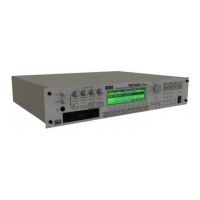PROG
1.1
2.12.22.33.14.14.25.15.25.36.17.17.27.3
17
JS–Y Int. to B (LFO1 JS–Y Int. to B) [–99…+99]
By receiving CC#2 (or by moving the joystick in the –Y
direction on a TRITON or other instrument connected to
MIDI IN), you can control OSC1 LFO1 to modulate the cut-
off frequency of filter 1B.
Specify the depth and direction of the effect. (
☞“JS –Y Int. to
A”)
AMS (LFO1 AMS) [Off, (PEG, FEG, AEG, KT, EXT)]
Selects a source that will control the depth and direction of
cutoff frequency change for both filters 1A and 1B (
☞p.206
“AMS List”).
Int. to A (LFO1 AMS Int. to A) [–99…+99]
Specifies the depth and direction of the effect that “AMS”
will have on filter 1A.
For example, if “AMS” is AfterT, higher settings of this
parameter will allow greater change to be applied to OSC1
LFO1 when you apply pressure to the keyboard of a con-
nected MIDI instrument.
Int. to B (LFO1 AMS Int. to B) [–99…+99]
Specifies the depth and direction of the effect that “AMS”
will have on filter 1B (
☞“Int. to A”).
LFO 2
Adjusts the depth of the cyclic modulation applied by OSC1
LFO2 (set by “OSC1 LFO 2” 5.3–2) to the cutoff frequency of
filters 1A and 1B (
☞“LFO 1” 4.1–4a).
Intensity to A (LFO2 Int. to A) [–99…+99]
Intensity to B (LFO2 Int. to B) [–99…+99]
JS–Y Int. to A (LFO2 JS–Y Int. to A) [–99…+99]
JS–Y Int. to B (LFO2 JS–Y Int. to B) [–99…+99]
AMS (LFO2 AMS) [Off, (PEG, FEG, AEG, KT, EXT)]
Int. to A (LFO2 AMS Int. to A) [–99…+99]
Int. to B (LFO2 AMS Int. to B) [–99…+99]
■ 4.1–4b: UTILITY
☞ “Write Program” (1.1–1d), “Copy Oscillator,” “Swap
Oscillator” (2.1–1d)
4.1–5: EG (Filter1 EG)
Here you can make settings for the EG that will produce
time-varying changes in the cutoff frequency of filters 1A
and 1B.
The depth of the effect that these settings will have on the
filter 1 cutoff frequency is determined by “Filter EG” (4.1–
2b).
4.1–5a: Filter1 EG
Specifies the time-varying change produced by the filter 1
EG.
L (Level):
The result will depend on the filter that was selected in
“Type (Filter Type)” (4.1–1a). For example with the Low
Pass Resonance filter, positive (+) values of “Int. to A” (4.1–
2b) will cause the tone to be brightened by positive (+) lev-
els, and darkened by negative (–) levels.
S (Start Level) [–99…+99]
Specifies the change in cutoff frequency at the time of note-
on.
A (Attack Level) [–99…+99]
Specifies the change in cutoff frequency after the attack time
has elapsed.
B (Break Point Level) [–99…+99]
Specifies the change in cutoff frequency after the decay time
has elapsed.
S (Sustain Level) [–99…+99]
Specifies the change in cutoff frequency that will be main-
tained from after the slope time has elapsed until note-off
occurs.
R (Release Level) [–99…+99]
Specifies the change in cutoff frequency that will occur when
the release time has elapsed.
T (Time):
These parameters specify the time over which each change
will occur.
A (Attack Time) [00…99]
Specifies the time over which the level will change from
note-on until the attack level is reached.
D (Decay Time) [00…99]
Specifies the time over which the level will change from the
attack level to the break point level.
S (Slope Time) [00…99]
Specifies the time over which the level will change after the
decay time has elapsed until the sustain level is reached.
R (Release Time) [00…99]
Specifies the time over which the level will change after
note-on occurs until the release level is reached.
4.1–5a
4.1–5b
4.1–5d4.1–5c
Note-on
Note-off
Attack
Time
Start
Level
Decay
Time
Release
Time
Release
Level
Attack Level
The specified
cutoff
frequency
Sustain Level
Time
Break
Point
Level
Slope
Time

